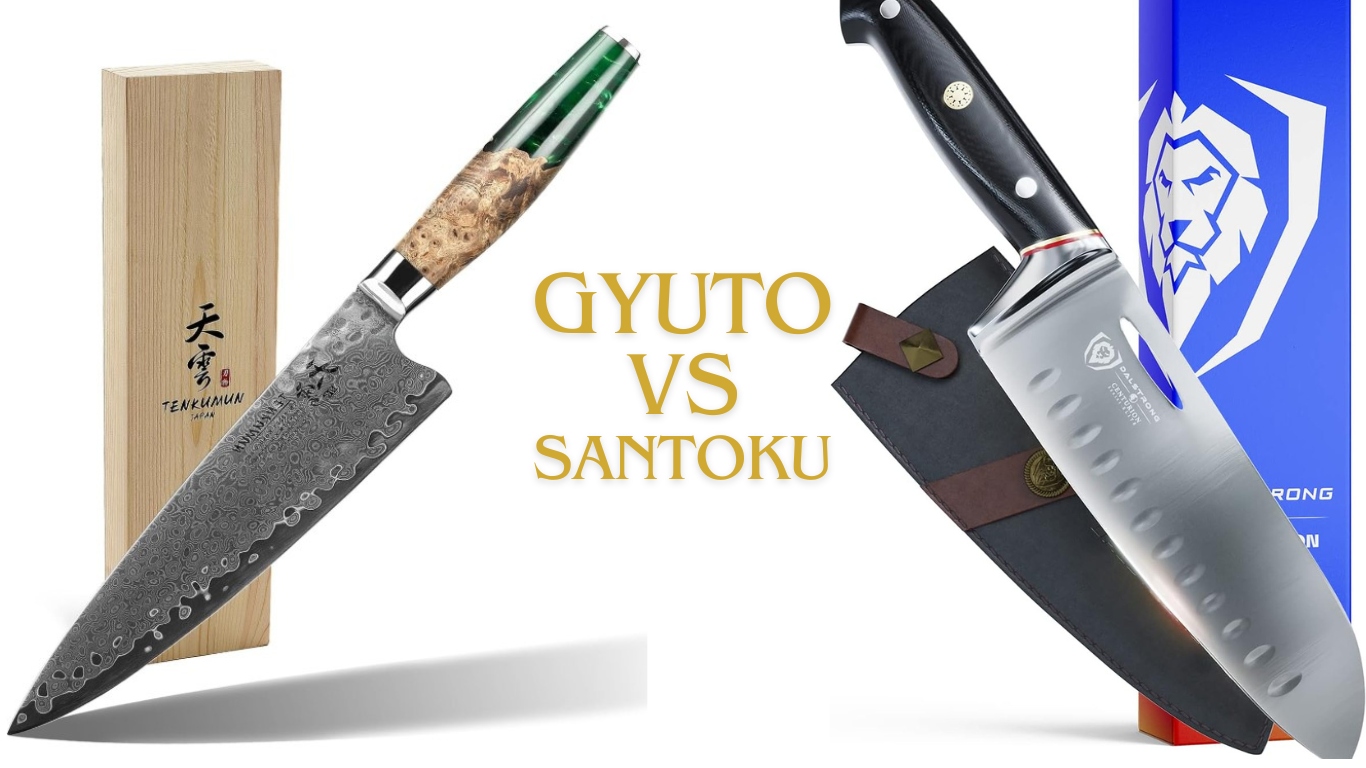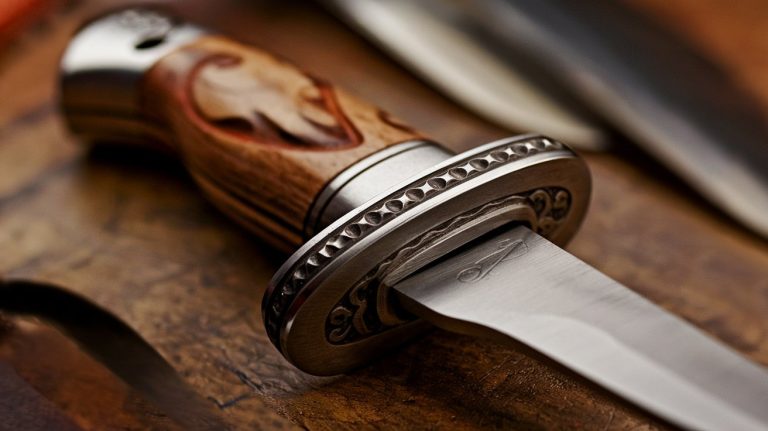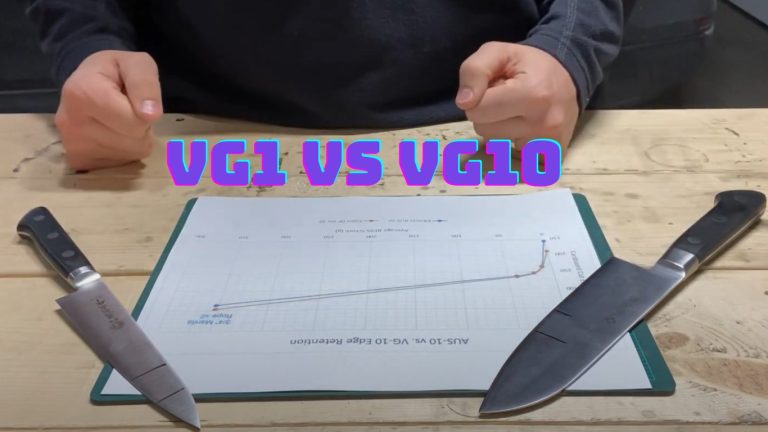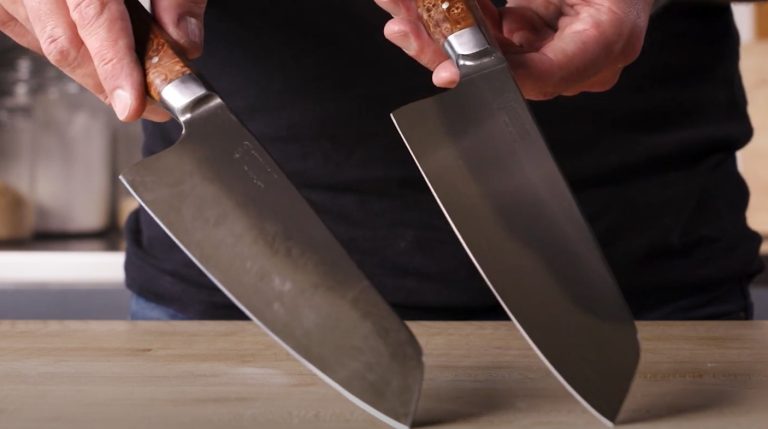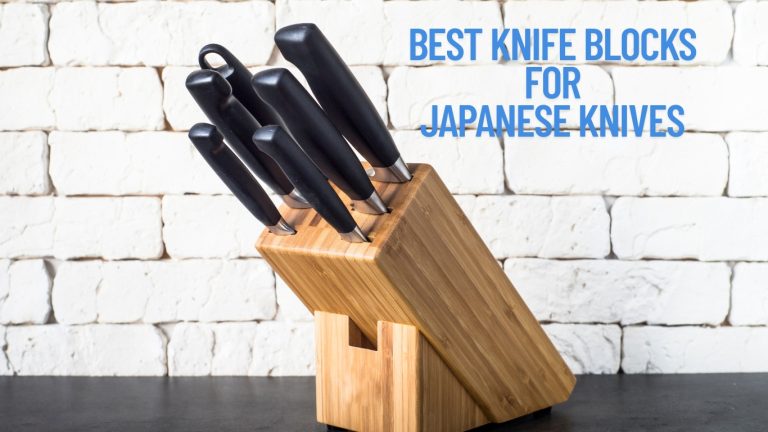Gyuto vs Santoku: Which Knife Will Elevate Your Cooking?
When deciding between a Gyuto and a Santoku, it’s essential to take into account their unique features. The Gyuto’s curved edge and pointed tip excel in rocking motions, making it great for meats, while the Santoku’s straight edge is perfect for precision slicing of vegetables.
Gyuto tends to be heavier, offering control, whereas Santoku is lighter for agility in the kitchen.
Each knife serves different culinary purposes, so exploring their strengths can truly enhance your cooking experience.
Key Takeaways
- Gyuto features a curved edge for rocking motions, while Santoku has a straight edge suited for chopping and push-cutting.
- Gyuto is heavier and provides better control for slicing meats, while Santoku is lighter and more agile for general kitchen tasks.
- Gyuto excels in tasks like herb chopping and meat handling, whereas Santoku shines in precision cutting of vegetables.
- Both knives are made from high-carbon steel, but Santoku offers better corrosion resistance and requires less frequent sharpening.
- Choosing between Gyuto and Santoku depends on cooking style, ingredient types, and cooking frequency.
Origin and Historical Context
Although both Gyuto and Santoku knives serve essential roles in Japanese kitchens today, their origins tell distinct stories shaped by historical and cultural contexts.
The Gyuto, born during the Meiji Era, reflects Japan’s embrace of Western influences. Inspired by German and French chef’s knives, it was crafted by skilled swordsmiths in Sakai, adapting their expertise from sword-making after the Sword Abolishment Edict.
This shift highlighted Japan’s cultural exchange with the West, as the Gyuto became essential for cutting red meat in a changing culinary landscape. The knife’s design, which features tall heels and a curved blade, enhances its versatility and effectiveness in various culinary tasks.
In contrast, the Santoku emerged post-WWII, addressing evolving cooking habits and the need for versatility. This knife, blending traditional and Western elements, signifies Japan’s adaptation to diverse diets, showcasing culinary evolution.
Design Characteristics
When it comes to design characteristics, the Gyuto and Santoku knives showcase unique features tailored to different culinary techniques.
The Gyuto, with its curved edge and pointy tip, excels in rocking motions, making it versatile for various tasks. In contrast, the Santoku’s straight edge and blunt, sheep’s foot tip are perfect for chopping and push-cutting.
While Gyutos are generally heavier and balance closer to the blade, Santokus offer a lighter, more agile feel, ideal for home cooks. Both knives are crafted from high-carbon steel, ensuring sharpness and durability.
Additionally, the Gyuto’s versatility makes it suitable for diverse cutting tasks, including meat preparation and precise slicing. The Gyuto’s blade characteristics also enhance its performance in achieving clean, precise cuts.
With Gyuto lengths ranging from 210mm to 270mm and Santokus typically between 160mm and 180mm, you’ll find that size and design play vital roles in your cutting experience.
Cutting Techniques Comparison
When you grab a Gyuto knife, you’ll appreciate its rocking motion that makes chopping herbs and vegetables effortless. Additionally, the Gyuto’s curved blade design enhances its versatility, making it suitable for a variety of cutting tasks.
On the other hand, the Santoku knife shines in precision cutting, allowing for clean dicing and slicing of softer ingredients.
Rocking Motion Advantage
While both Gyuto and Santoku knives excel in various kitchen tasks, the Gyuto’s design truly shines when it comes to rocking motion. Its curved blade edge enhances your cutting experience, allowing for precise, fluid movements.
Here are three advantages of the Gyuto’s rocking motion:
- Rock Chopping: The curvature facilitates efficient rock chopping, perfect for dicing vegetables or herbs.
- Meat Handling: Its design excels in loosening tendons and cutting around bones, making meat preparation seamless; this is particularly beneficial when using a razor-sharp boning knife for precise cuts.
- Motion Control: The continuous curve guarantees consistent cuts, enhancing your overall efficiency. Additionally, the Gyuto knife’s longer blade length provides greater versatility in handling various tasks.
Precision Cutting Techniques
Understanding the precision cutting techniques of Gyuto and Santoku knives can greatly enhance your culinary skills.
Gyuto knives feature a curved edge and a pointed tip, making them ideal for intricate meat cuts and detailed scoring. Their longer blade provides leverage, perfect for julienne or brunoise techniques.
Additionally, the Gyuto’s versatility allows chefs to tackle a wide range of cutting tasks beyond just meat, as they can also be used for various vegetables with ease.
In contrast, Santoku knives offer a straighter edge, excelling in clean, uniform cuts, especially with vegetables and fruits. Their flat or rounded tip guarantees smooth slicing without crushing.
While both knives are sharp, Gyuto’s tapered edge is designed for precision, whereas Santoku maintains sharpness for consistent cuts.
Versatility in Kitchen Applications
Both the Gyuto and Santoku knives shine in their versatility, making them invaluable tools in any kitchen.
Depending on your cooking style and needs, each knife offers unique advantages:
- Meat Preparation: A Gyuto excels at handling larger cuts, giving you the control needed for precise slicing.
- Vegetable Handling: The Santoku is perfect for dicing and mincing veggies, ensuring clean, even cuts. The wide, flat blade of a Santoku enhances its ability to transfer food easily.
- Chopping Techniques: While the Gyuto supports a rocking motion, the Santoku shines with its straight chopping capabilities.
Whether you’re slicing meat or prepping vegetables, both knives can tackle most tasks.
Materials and Construction
When choosing between a Gyuto and a Santoku, the blade material plays an essential role in your cooking experience. You’ll notice that both knives often feature high-carbon and stainless steel options, affecting their weight and balance during use.
Understanding these materials helps you select the knife that best fits your style and needs in the kitchen. The Gyuto’s thinner blade typically requires more frequent sharpening compared to the Santoku, which can influence your maintenance routine.
Additionally, the corrosion resistance of the materials can significantly impact how often you need to care for your knife.
Blade Material Options
Choosing the right blade material for your Gyuto or Santoku knife can considerably impact your cooking experience. Understanding the various options helps you make an informed decision that suits your culinary needs. Here are three popular blade materials to evaluate:
- High-Carbon Steel: Offers excellent edge retention and sharpness but requires regular maintenance to prevent rust. High-carbon steel is often preferred for its ability to maintain a sharp edge longer than other materials, making it ideal for precision tasks.
- Stainless Steel: Provides good rust resistance and durability, though it may not hold an edge as long as high-carbon options. Regular visual inspections help maintain performance and ensure safety with stainless steel knives.
- Laminated Steel: Combines a hard inner core for sharpness with a softer outer layer for corrosion resistance, striking a balance between performance and maintenance.
Weight and Balance
Weight and balance play an essential role in the performance and feel of Gyuto and Santoku knives.
Gyuto knives, typically heavier, range from 7 to 18.8 ounces, providing the force needed for chopping dense ingredients. In contrast, Santoku knives weigh between 7.7 to 10.6 ounces, offering greater control for delicate tasks.
Their shorter length makes them more maneuverable, with a centralized balance point enhancing ease of use. The Gyuto’s balance and weight distribution significantly contribute to its effectiveness in various cutting techniques.
Both knives often feature full-tang construction, ensuring durability, but their weight differences considerably affect handling. If you prefer precision in slicing and chopping, the Santoku might be your choice.
Selecting the Right Knife for Your Needs
How do you know which knife suits your cooking style best? Choosing between a Gyuto and a Santoku can enhance your culinary experience considerably.
Consider these factors:
Consider your cutting techniques, ingredient types, and cooking frequency to find the perfect knife that enhances your culinary journey.
- Cutting Techniques: If you love rock chopping and versatile techniques, a Gyuto’s curved blade is ideal. The Gyuto’s curved edge profile allows for seamless transitions between various cutting methods.
- Ingredient Types: A Gyuto performs well with meats and tougher ingredients, while the Santoku shines with delicate vegetables and fruits.
- Cooking Frequency: If you cook often and enjoy diverse styles, a Gyuto is your best bet. For occasional cooks focused on veggies, a Santoku might suit you better.
Maintenance and Care Tips
To keep your Gyuto or Santoku knife in top condition, regular maintenance is essential.
Start by washing your knife by hand with mild soap and warm water; avoid harsh chemicals and abrasive materials that can damage the blade. After cleaning, dry it thoroughly with a soft cloth to prevent corrosion—never use a dishwasher.
Proper knife care ensures longevity and sharpness, making it vital for your kitchen tools. Additionally, using a sharp knife reduces the risk of slipping and enhances safety while cooking.
For storage, opt for a knife block, magnetic strip, or magnetic rack, ensuring proper ventilation and avoiding overcrowding.
Regularly sharpen your knife using the correct angle and grit to maintain its performance. If you have a wooden handle, oil it regularly and clean it to remove food particles.
Frequently Asked Questions
Which Knife Is Better for Beginners, Gyuto or Santoku?
When choosing a knife as a beginner, consider your cutting style and comfort.
If you prefer versatility and are willing to master various techniques, a Gyuto might suit you. However, if you want something lightweight and easier to handle for straightforward cuts, a Santoku could be the better option.
Both knives offer unique features, so think about what tasks you’ll tackle most often in the kitchen before making your decision.
Can Gyuto and Santoku Knives Be Used Interchangeably?
Imagine standing in a bustling kitchen, vibrant ingredients waiting for your touch. You might wonder if you can use a Gyuto and a Santoku knife interchangeably.
While both are versatile and handle various tasks, their designs cater to different cutting techniques. You’ll find the Gyuto excels in precision and rocking motions, while the Santoku shines in chopping.
Ultimately, choosing one over the other shapes your culinary experience, enhancing your cooking journey.
How Do I Sharpen Gyuto and Santoku Knives Effectively?
To sharpen your knives effectively, start by selecting a medium to fine whetstone.
For both types, keep a consistent angle—around 10 to 15 degrees.
Focus on the pointed tip of your Gyuto, adjusting the angle slightly for precision, while maintaining the flatness of your Santoku’s edge.
Don’t forget to remove the burr afterward for a smooth finish.
Regular sharpening and proper techniques will keep your knives performing at their best!
Are There Specific Brands Recommended for Gyuto or Santoku Knives?
When you’re searching for the perfect knife, think of it as choosing a trusted companion in your culinary journey.
For gyuto knives, brands like Misono and Takamura shine with their exceptional craftsmanship and razor-sharp blades.
If you’re leaning toward santoku knives, consider Shun or Global for their balance and precision.
Each brand brings its unique flair, ensuring you’ll slice through your ingredients with the grace of a dancer on stage.
What Is the Price Range for Quality Gyuto and Santoku Knives?
When considering quality knives, you’ll find that gyuto knives typically range from around $80 to over $600 CAD, depending on materials and craftsmanship.
For santoku knives, prices often start under $50 and go up to $300 for high-end options.
Mid-range gyuto knives offer a balance of quality between $150 and $300, while santoku knives in the same range provide excellent value for everyday cooking needs, catering to various preferences and budgets.
Transform Your Cooking: The Right Blade Makes All the Difference
In choosing between the gyuto and santoku, consider your culinary cravings. Both blades boast brilliant benefits, but it’s essential to match their mastery to your menu.
Whether you’re slicing, dicing, or chopping, each knife has its distinctive design and delightful advantages. So, stay savvy and select the one that suits your slicing style best.
With the right knife in hand, you’ll transform tedious tasks into tantalizing triumphs in the kitchen.

